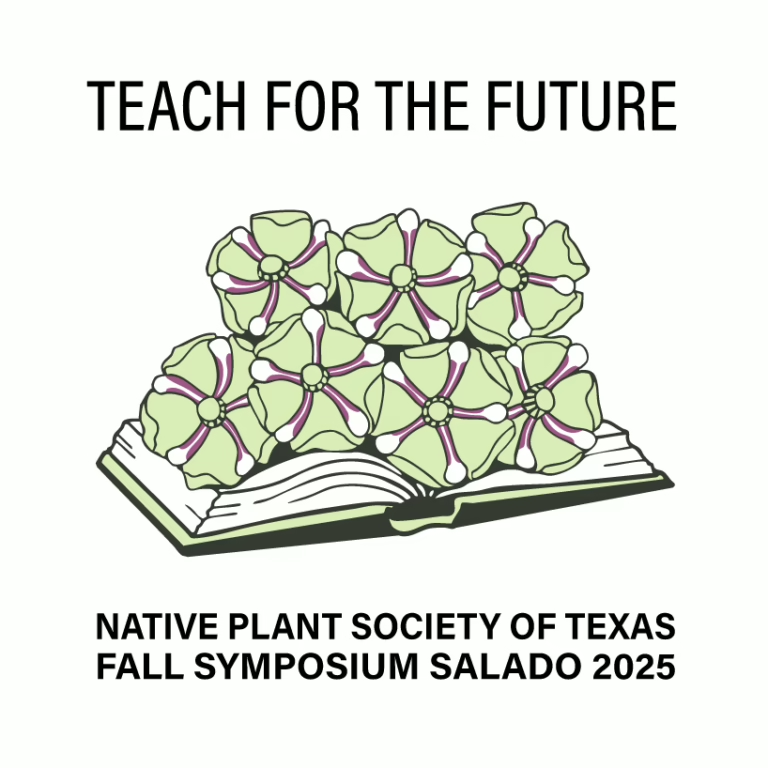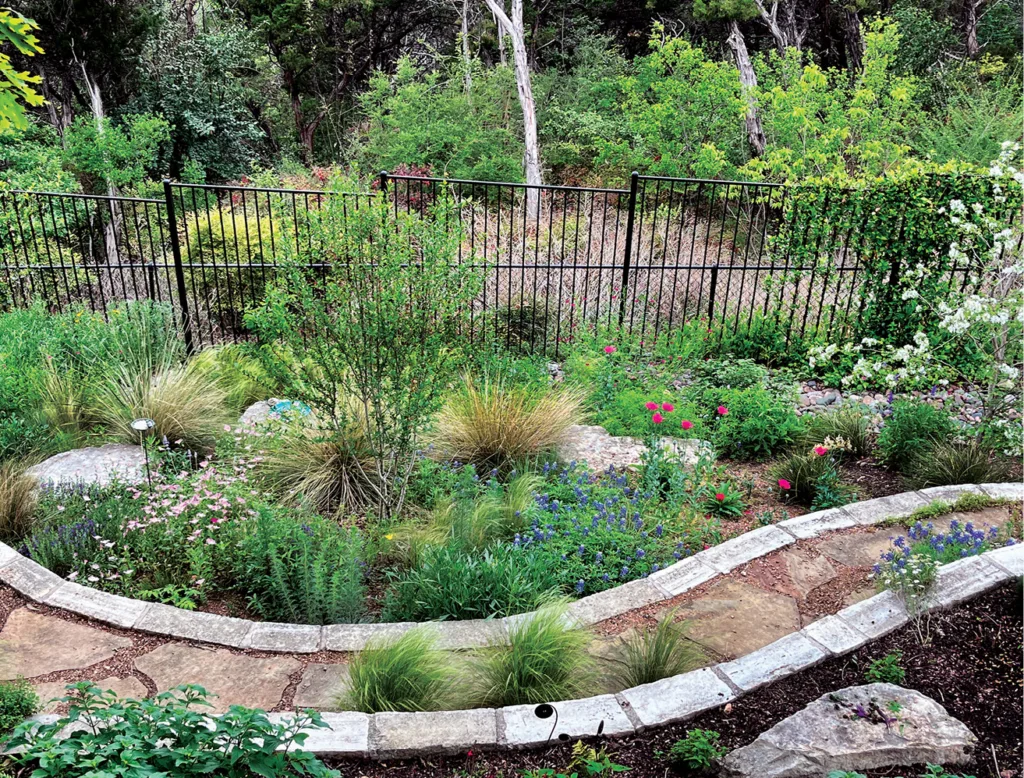
The Art of Native Plant Landscaping: From Mistakes to Mastery
By Michelle Michel, Austin Chapter

Gardening has charmed me since I was a child. However, I’ve never really been a great gardener. Weeds make me crazy; fertilizer intimidates me, bugs gross me out. I’ve always wanted to be one of those people who could be on an outdoor walk and casually name all the plants I come across. My mom is like that. This is the story of how a garden brought me closer to being that person, how it taught me so much, including how to let go of control, and how it practically saved my life.
In the summer of 2017, we downsized from our Austin home of 18 years. The house we chose to steward sits adjacent to Bright Leaf Preserve–two hundred acres of untouched woodlands in the Edwards Plateau, seven miles from downtown Austin. The backyard–a nice but not overwhelming size of 100 x 30 feet–was heavily sloped and mostly overrun with tall grasses, aggressive vines, and a mishmash of sages and salvias.
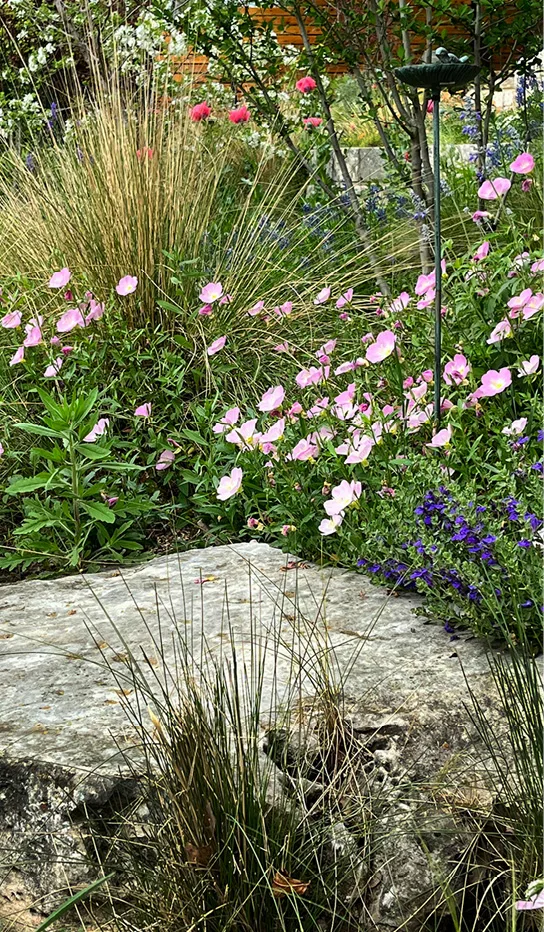
We knew we didn’t want another turf lawn. I wanted something low maintenance, and after 30 years in Austin I knew we needed drought-tolerant plants. Furthermore, I wanted mostly native plants, due to my limitations as a gardener. Over the years I’d come to realize I could practically pop a native in the soil, do little else, and it would somehow still thrive.
The backyard did have some existing features we wanted to keep and incorporate into the overall design–a raised limestone bed directly below the deck, and a flagstone pathway. In my head I saw more pathways curving throughout the yard, several raised terraced beds, and maybe another outdoor living area. We contacted a landscape architect to help put my scattered vision to paper, and a year later that vision became reality.
The project was completed in June of 2019, and I absolutely loved the results. Freshly mulched beds with such a lovely variety of plants, a meandering wash of river rock, and a large free-form dry meadow bed of decomposed granite filled with gems such as Gulf Muhly Grass (Muhlenbergia capillaris), Sotols (Dasylirion spp.) Mexican Feather Grasses (Nassella tenuissima), and Blackfoot Daisies (Melampodium leucanthum). It did, in fact, require a great deal of watering, and I, being a novice gardener, overwatered.
The backyard garden began to teach me lessons almost immediately. The first being that no intentional landscape is going to be completely “maintenance-free”. Right away weeds began to pop up, especially in all that lovely, rich decomposed granite. That first year or so I worked myself silly trying to extract each and every weed that dared rear their ugly heads. Plus, I’d killed some of my poor plants with my zealous overwatering, and needed to replace them. Thus, I discovered the joys of nursery and plant sale shopping. Of course, what is bought must be put into the ground. More work.
Then in March 2020 the pandemic turned our world upside down, and suddenly I was at home ALL the time. The only (healthy) thing that seemed to take my mind off the world’s problems was being outside in my backyard garden. The time I spent there working, observing, and thinking was meditative and therapeutic. A series of classes I’d signed up for at the Lady Bird Johnson Wildflower Center six months prior were postponed, then offered online.

I learned SO much, but was a little overwhelmed as to how to apply all that knowledge to my little slice of heaven. Then I found a garden consultant online. Through Zoom calls, we exchanged photos and videos, and she gave me pruning and design tips. She also encouraged me to wean my plants from their heavy watering schedule (they were drought-tolerant, for crying out loud).
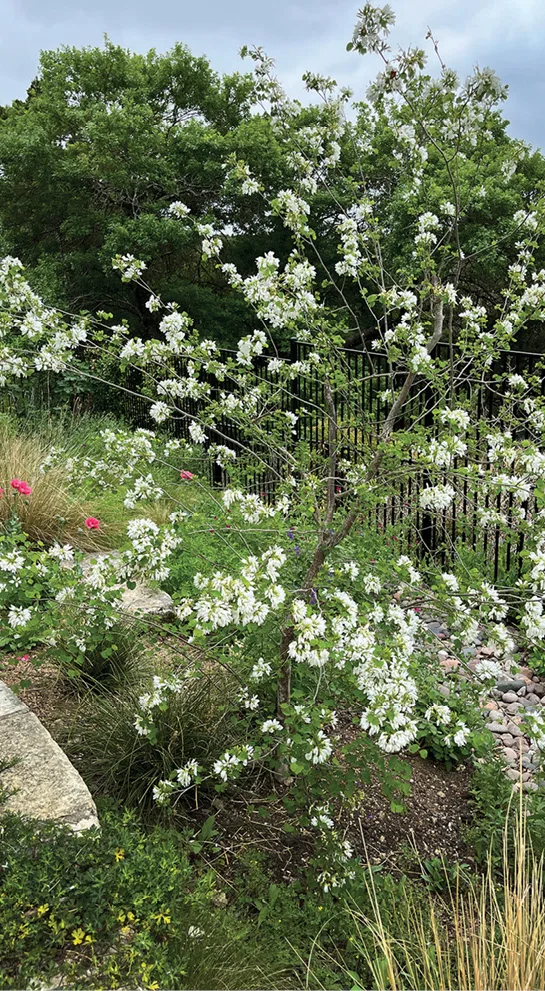

Planting primarily natives alongside so-called adapted plants taught me the most. Experience is the best teacher. Plants native to my ecoregion are more resistant to pests, drought-tolerant, and more apt to withstand our extreme Texas weather. Those natives that seem at first like they’ve not made it are usually the ones to come back. Plants in their element do have a strong will to live, and there’s so much life underground! Even if they seem dead, I’ve learned to let the roots be for at least a season.
After the Snowpocalypse of 2021, I thought I’d lost so many plants. Most of those that actually did die were not natives, such as the Japanese Aralias (Fatsia japonica), Star Jasmines (Trachelospermum jasminoides), and Dwarf Crepe Myrtles (Lagerstroemia). Most have since been replaced by far more resilient native plants.
For example, the crepe myrtles were not only severely damaged by our more frequent deep freezes, they would become infested with a horde of aphids every year, leaving awful “black soot”. They’ve since been replaced by native Yaupon Hollies (Ilex vomitoria), which may be my most favorite scientific name) which quickly proved their resilience by surviving a summer of record heat.
The Wildflower Center inspired me to try planting wildflower seed balls sold in their gift shop. All that’s needed is to scatter those seed balls in the soil in the fall, water a little, and leave them alone. The following spring, to my delight, I had a full-blown mini wildflower meadow! I’ve found other treasures at the Wildflower Center and the Society’s plant sales I’ve been unable to find anywhere else, such as my sweet Woolly Globe Mallow (Sphaeralcea lindheimeri).

As my garden has filled in, the weeding has become less arduous. I discovered pecan shell mulch (used at the Wildflower Center) is an amazing weed barrier, breaks down more slowly than traditional mulch, and sounds lovely crunching under my feet. The meadow bed filled with the rich decomposed granite does produce more weeds, but I’m now more relaxed about needing to pull them all. Plus, now that the wildflowers reseed every spring, I’m better able to tell the difference between a newly-sprouted wildflower and a weed.

Some of my favorite plants are the natives that attract and provide nourishment for the fauna in my area. The hummingbirds love the Red Yucca (Hesperaloe parviflora), Flame Acanthus (Anisacanthus quadrifidus), Tropical Sage (Salvia coccinea), and Autumn Sage (Salvia greggii). Butterflies go for the Shrubby Boneset (Ageratina havanesis) and Gregg’s Mistflower (Conoclinium greggii), not to mention all the wildflowers, and the bees become practically drunk inside the datura’s (Datura spp.) giant moonflowers. This year I caught a shy Texas spiny lizard digging a hole below a patch of Four Nerve Daisies (Tetraneuris scaposa) to lay her clutch of eggs, and now I’m seeing little baby lizards darting everywhere!
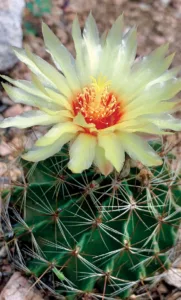
From the recommendation of my garden consultant I discovered my all-time favorite little native tree, the Anacacho Orchid (Bauhinia lunarioides). Its deeply cleft leaves and delicate white flowers never fail to enchant me.


I received a deep discount on one whose trunk had been severely topped and whose main branches were badly crisscrossed. It’s my sweet little rescue tree no one else wanted and has been teaching me so much about the benefits of proper pruning.
There have been other challenges–this is Texas, after all. My rocky limestone soil is nearly impossible to dig. Thank goodness for all those raised beds! I’m in constant war with armadillos, rock squirrels, and other critters. We had terrible problems with a screen of Japanese Yews (Taxus cuspidata). One became diseased and died, and we spent hundreds of dollars trying to replace it several times, only to have those die also. Then they died back completely after the snow of 2021. We’ve since replaced them with some wonderful Texas Mountain Laurels (Dermatophyllum secundiflorum), whose intoxicating grape Kool-Aid scented flowers just knock me off my feet.
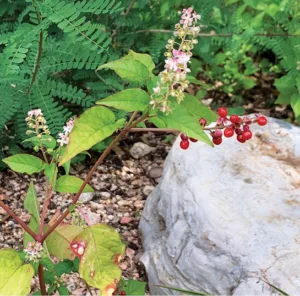
This past summer’s extreme heat taught me which plants are the hardiest: my Desert Willow (Chilopsis linearis), Possumhaw Holly (Ilex decidua), Pigeonberry (Rivina humilis), Anacacho Orchid (Bauhinia lunarioides), Texas Persimmon (Diospyros texana), and Kidneywood (Eysenhardtia texana) all thumbed their noses at the 107-degree heat.
Because the soil in the Edwards Plateau region is more alkaline than many other areas, I have to be careful what plants I select. I find I’ve become frustrated with nurseries that offer plants that are more difficult to grow here, or are invasive, or you think you’re buying native, only to find it’s actually a non-native cultivar (I’m looking at you, yellow bells and lantana).
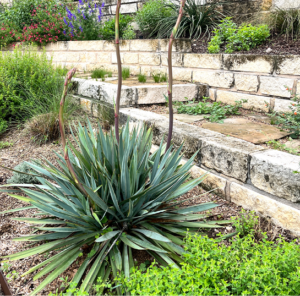
Every year I learn something new. A favorite plant dies, and a new plant I’ve fallen in love with is introduced–this year I’m pining over Antelope Horns Milkweed (Asclepias asperula ssp. capricornu) and Blue Grama Grass (Bouteloua gracilis). Each year my backyard garden changes and morphs into something completely different.
In 2022 I contacted the Travis County Extension office and applied for their Master Gardener training program. After completing their Horticultural Principles and Practices class online and taking a grueling exam I was chosen to serve as a Master Gardener intern. I still feel like I’m a novice, but now I also feel equipped to meet gardening challenges. And it all started with a bit of earth in my own backyard.
Michelle Michel can be reached at
All photos by Michelle Michel
Did you like this article? It’s from our Fall 2023 Texas Native Plants magazine. Read more here



